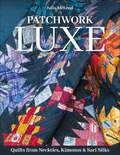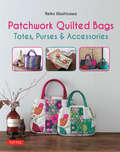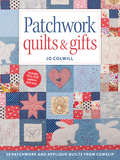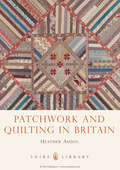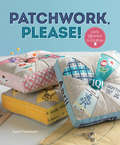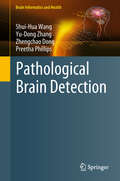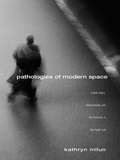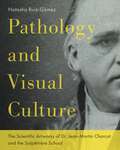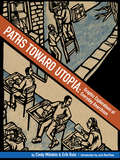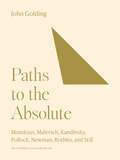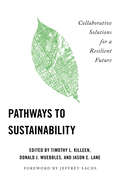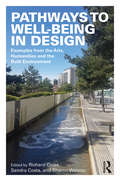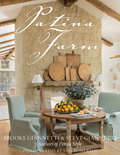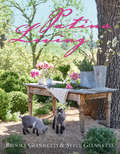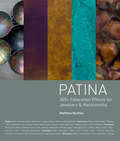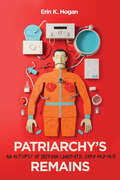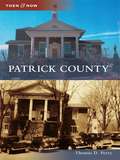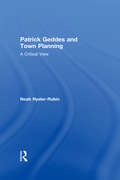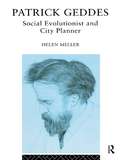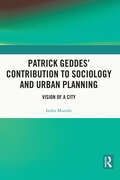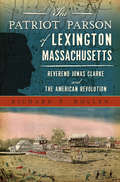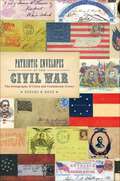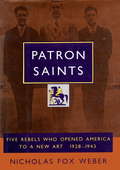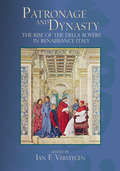- Table View
- List View
Patchwork Luxe: Quilts from Neckties, Kimonos & Sari Silks
by Julia McLeodMaster the art of quilting with cherished silk fabrics! Learn techniques to tame silk’s challenging qualities and create gorgeous silk quilts! From working with reclaiming materials like ties, scarves, and garments to exploring the history of sericulture and its use in historic quilts, you’ll find the secrets to quilting with silks. Discover key techniques when working with silks, including traditional machine piecing with fusible interfacing, improv piecing, fabric foundation piecing, fussy cutting, appliqué, finishing, and more! From sarees to kimono, you’ll explore ways to combine various silks in one project. Put newfound skills to work, breathing life into quilt projects that range from bed-sized quilts to home decor items. Perfect for quilters of all skill levels, whether you’re a traditionalist or a modern enthusiast Work your way to zero waste and transform your sentimental attire and textiles into treasured heirlooms with confidence. Find inspiration in the projects and stunning photo gallery included, making this book the perfect guide for crafting memory quilts from your loved one’s clothing.
Patchwork Quilted Bags: Totes, Purses and Accessories
by Reiko WashizawaPatchwork Quilted Bags helps you create unique bags that put a little charm into carrying your stuff around or storing the things you don't need every day.Full-sized quilting patterns and step-by-step instructions for 19 different projects, along with techniques for assembling the perfect patch, make this quilting book ideal for novice and practiced crafters alike. Projects range in size from large totes to small pouches in a zakka vein. With Patchwork Quilted Bags you can make: A bird-themed travel bag An elegant lace-rimmed bucket bag A colorful clasp purse A round bag/basket A fold-away eco bag A baby bag with bottle "cozy" Adorable animal-themed totes A Union-Jack themed pouch And more! This colorful and user-friendly quilting book shows you lots of creative ways to use every type of patch from squares to yoyos, and every type of print from florals to newsprint. Pages showcasing different patchwork quilts add inspiration for mixing traditional and contemporary forms. It's the perfect way to have fun with fabric and make a practical work of art.
Patchwork Quilts & Gifts: 20 Patchwork and Appliqué Quilts from Cowslip
by Jo ColwillIn Patchwork Quilts & Gifts Jo demonstrates a wide range of patchwork and quilting techniques suitable for the beginner to the more experienced sewer, including her unique template-free and bondaweb applique, needle-turn applique, hand and machine quilting, embroidery and embellishing.The 10 full-size quilt designs are accompanied by10 smaller projects which use a motif or design taken from the original quilt enabling you to make up quick patchwork projects to accessorize your home or for a fabulous gifts for family and friends. Projects include cushions, hangings, a needle cushion and a cuddly rabbit and offering a fantastic 'taster' of Jo's designs if you don't feel ready to tackle a full quilt but there are, plenty of larger scale projects for the more experienced sewer looking for a challenge.Jo Colwill is an expert patchworker and quilter with over 25 years experience and the owner of Cowslip Workshops, a haven for quilters in the UK, where she runs patchwork and applique classes.
Patchwork and Quilting in Britain
by Heather AudinPatchwork quilts are hugely evocative emblems of our domestic past. With no two quite the same, each example hints both at the story of the particular household in which it was produced and at a larger piece of social history. But quilting is by no means only historical, with the craft seeing a huge revival in popularity in recent years, and items that were once made for purely utilitarian and practical reasons are now produced and appreciated for the connection they afford us to a rich vein of heritage and nostalgia. Illustrated with a stunning range of examples from the Quilters' Guild Collection - of which the author is curator - this book is a wonderful introduction to a hugely important aspect of British domestic history.
Patchwork, Please!: Colorful Zakka Projects to Stitch and Give
by Ayumi TakahashiGet fresh inspiration with 19 quick and colorful projects!In Patchwork, Please!, Stitch magazine contributor Ayumi Takahashi has created playful and practical patchwork projects for the home and the people who live in it. Sewing should be fun, and Ayumi Takahashi's patchwork projects embody that happy, playful approach.Known for both her distinctive combination of patterned fabrics and her quirky interpretations of vintage style, Ayumi brings this signature approach to 19 sewing projects. The book begins with basic techniques in patchwork, paper piecing, raw-edged applique, and machine and hand embroidery. Then it's straight into an appealing assortment of projects for the kitchen, home, family, and friends.Along the way, Ayumi shares her passion for color and pattern and even demonstrates how to create unique patterns by scanning and transferring images onto fabric for a truly personal touch.
Pathological Brain Detection (Brain Informatics and Health)
by Shui-Hua Wang Yu-Dong Zhang Zhengchao Dong Preetha PhillipsThis book provides detailed practical guidelines on how to develop an efficient pathological brain detection system, reflecting the latest advances in the computer-aided diagnosis of structural magnetic resonance brain images. Matlab codes are provided for most of the functions described. In addition, the book equips readers to easily develop the pathological brain detection system further on their own and apply the technologies to other research fields, such as Alzheimer’s detection, multiple sclerosis detection, etc.
Pathologies of Modern Space: Empty Space, Urban Anxiety, and the Recovery of the Public Self
by Kathryn MilunPathologies of Modern Space traces the rise of agoraphobia and ties its astonishing growth to the emergence of urban modernity. In contrast to traditional medical conceptions of the disorder, Kathryn Milun shows that this anxiety is closely related to the emergence of "empty urban space": homogenous space, such as malls and parking lots, stripped of memory and tactile features. Pathologies of Modern Space is a compelling cultural analysis of the history of medical treatments for agoraphobia and what they can tell us about the normative expectations for the public self in the modern city.
Pathology and Visual Culture: The Scientific Artworks of Dr. Jean-Martin Charcot and the Salpêtrière School
by Natasha Ruiz-GómezIn this book, Natasha Ruiz-Gómez delves into an extraordinary collection of pathological drawings, photographs, sculptures, and casts created by neurologists at Paris’s Hôpital de la Salpêtrière in the nineteenth century. Led by Dr. Jean-Martin Charcot (1825–1893) and known collectively as the Salpêtrière School, these savants-artistes produced works that demonstrated an engagement with contemporary artistic discourses and the history of art, even as the artists/clinicians professed their dedication to absolute objectivity.During his lifetime, Charcot became internationally famous for his studies of hysteria and hypnosis, establishing himself as a pioneer in modern neurology. However, this book brings to light the often-overlooked contributions of other clinicians, such as Dr. Paul Richer, who created “scientific artworks” that merged scientific objectivity with artistic intervention. Challenging conventional interpretations of visual media in medicine, Ruiz-Gómez analyzes how these images and objects documented symptoms and neuropathology while defying disciplinary categorization.Grounded in extensive archival research, Pathology and Visual Culture targets an international audience of historians and students of art, visual culture, medicine, and the medical humanities. It will also captivate neurologists and anyone interested in fin-de-siècle French history and culture.
Paths Toward Utopia: Graphic Explorations of Everyday Anarchism
by Cindy Milstein Josh MacPheeConsisting of 10 collaborative picture-essays that weave poetic words with intricate yet bold images, this collection aims to challenge readers into thinking of community action in a positive light. Depicting what it would be like to live, every day, in a world created from below, where coercion and hierarchy are largely vestiges of the past, Paths Toward Utopia suggests some of the practices that prefigure the self-organization that would be commonplace in an egalitarian society. This stirring book ultimately mines what people do in their daily lives for the already-existent gems of a freer future—premised on anarchistic ethics like cooperation and direct democracy.
Paths to the Absolute: Mondrian, Malevich, Kandinsky, Pollock, Newman, Rothko, and Still (The A. W. Mellon Lectures in the Fine Arts #48)
by John GoldingA groundbreaking account of the meaning of abstract paintingFrom Mondrian's bold geometric forms to Kandinsky's use of symbols to Pollock's "dripped paintings," the richly diverse movement of abstract painting challenges anyone trying to make sense of either individual works or the phenomenon as a whole. Applying his insights as an art historian and a painter, John Golding offers a unique approach to understanding the evolution of abstractionism by looking at the personal artistic development of seven of its greatest practitioners. He re-creates the journey undertaken by each painter in his move from representational art to the abstract—a journey that in most cases began with cubism but led variously to symbolism, futurism, surrealism, theosophy, anthropology, Jungian analysis, and beyond. For each artist, spiritual quest and artistic experimentation became inseparable. And despite their different techniques and philosophies, these artists shared one goal: to break a path to a new, ultimate pictorial truth.The book first explores the works and concerns of three pioneering European abstract painters—Mondrian, Malevich, Kandinsky—and then those of their American successors—Pollock, Newman, Rothko, and Still. Golding shows how each painter sought to see the world and communicate his vision in the purest or most expressive form possible. For example, Mondrian found his way into abstraction through a spiritual response to the landscape of his native Holland, Malevich through his apprehension of the human body, Kandinsky through a blend of religious mysticism and symbolism. Line and color became the focus for many of their creative endeavors. In the 1940s and 50s, the Americans raised the level of pictorial innovation, beginning most notably with Pollock and his Jung-inspired concept of action.Golding makes a powerful case that at its best and most profound, abstract painting is heavily imbued with meaning and content. Through a blend of biography, art analysis, and cultural history, Paths to the Absolute offers remarkable insights into how a sense of purpose is achieved in painting, and how abstractionism engaged with the intellectual currents of its time.Please note: All images in this ebook are presented in black and white and have been reduced in size.
Pathways to Sustainability: Collaborative Solutions for a Resilient Future
by Timothy L. Killeen; Donald J. Wuebbles; Jason E. LaneIn an era defined by unprecedented environmental challenges and rapid societal change, how can we build a sustainable and resilient future? In this collection, the editors bring together groundbreaking insights and inspiring stories from around the globe, illuminating how innovative partnerships across sectors and borders are driving meaningful progress toward sustainability. Contributors from science, business, non-governmental organizations, and university leadership engage across their areas of expertise to discuss how to apply cutting-edge research toward understanding, mitigating, and adapting to today’s alarming environmental stresses. Throughout, the essayists showcase breakthroughs in sustainability science while providing a blueprint for creating collaborations, expanding networks, and connecting with new markets. Essential reading for sustainability leaders, educators, policymakers, and change-makers everywhere, this volume offers a visionary yet practical roadmap for harnessing the power of collaboration to advance practical solutions necessary to ensure a thriving planet for future generations. Expert and interdisciplinary, Pathways to Sustainability focuses on human capacity building and innovation to explore holistic solutions to climate change, unsustainable resource consumption, and other inevitable challenges of our time. Contributors: Nicole Arbour, Rebecca T. Barnes, Kyle Blount, Kayla Boparai, Caleb S. Brooks, Benjamin B. Campion, Christopher Castle, William L. Chadderton, Kenneth T. Christensen, Emily M. Clegg, Asher Cohen, Jonathan Coppess, Nathan L. Cummins, John D. Den Uyl, Miranda N. Domico, Francina Dominguez, Patrick J. Doran, Kelvin K. Droegemeier, Pengyue Du, Luis Gomez Echeverri, Brian Fath, John Ferry, Trent W. Ford, Regina Mae Francia, Georgie B. Geraghty, Janet Gooch, Timothy P. Grunloh, Kaiyu Guan, Luiz Gutierrez, Sam S. Haapaniemi, Julian Heiss, Barb Helland, Catherine Hurley, Atul K. Jain, Paul Kearns, Timothy L. Killeen, Rao Kotamarthi, Jason E. Lane, Wendy Larner, John T. Legge, L. Ruby Leung, Peiyuan Li, Leila Loupis, Josephine M. Malonza, Mark Manns, Lia Merminga, Maria J. Molina, David Muchangi Mugo, Meridith F. Muth, Selvaprabu Nadarajah, Cristina Negri, Pratik Patil, Andreas F. Prein, Ziqi Qin, Fany Ramos Quispe, Jonathan Radcliffe, Omer Rana, Dan Reed, Alyssa Rodway, Christine Rovelli, Elena Rovenskaya, Gabriella Pinheiro Servi, Gavin Shaddick, John Shalf, Ashish Sharma, Bjorn Stevens, Tih-Fen Ting, Dennis Todey, John Towns, Andrew J. Tucker, Albert van Jaarsveld, Carolina Veiga, Abhinav Wadhwa, Peter W. Wangai, Melissa Widhalm, Aaron B. Wilson, Molly Woloszyn, Sicheng Wu, Donald J. Wuebbles, and Joel Zavala
Pathways to Well-Being in Design: Examples from the Arts, Humanities and the Built Environment
by Richard Coles Sandra Costa Sharon WatsonHow can we achieve and promote well-being? Drawing on examples from the arts, humanities and design, this book brings together work from a wide range of areas to reveal the unique ways in which different disciplines approach the universal goal of supporting well-being. Pathways to Well-Being in Design recognises that the distinction between academics and practitioners often becomes blurred, where, when working together, a fusion of thoughts and ideas takes place and provides a powerful platform for dialogue. Providing new insights into the approaches and issues associated with promoting well-being, the book's multi-disciplinary coverage invites readers to consider these ideas within the framework of their own work. The book's 12 chapters are authored by academics who are involved in practice or are working with practitioners and features real world case studies which cover a range of situations, circumstances, environments, and social groups. Pathways to Well-Being in Design responds to those wishing to enquire further about well-being, taking the reader through different circumstances to consider approaches, discussing practice and theory, real world and virtual world considerations. This book is essential reading for anyone seeking to understand well-being, including students and professionals in architecture, landscape architecture, urban planning, design and health sciences.
Patina Farm
by Brooke Giannetti Steve GiannettiThe husband and wife team behind Giannetti Home welcome readers into their gorgeous farm residence blending modern style with French antiques. When Brooke and Steve Giannetti decided to leave their suburban Santa Monica home to build a new life on a farm, they traveled to Belgium and France for design inspiration. In Patina Farm they share their collaborative process, as well as the enviable result of their team effort and creativity: an idyllic farm in California&’s Ojai Valley. With two hundred gorgeous photographs and Steve&’s architectural drawings, Brooke takes readers through their inspirations, thought process, and materials selections. Readers are given a full tour of the family home, guesthouse, lush gardens, and delightful animal quarters.
Patina Living
by Brooke Giannetti Steve GiannettiThe husband and wife design team takes readers on a guided tour of their elegant farm residence in Ojai, CA—a home full of Patina Style inspiration. Brooke and Steve Gianetti offer an intimate look at their life on Patina Farm, the home they designed with an interplay of rustic and modern European charm. Beyond the gorgeously appointed farmhouse, the Giannettis readers through the sheds, outbuildings and gardens where they entertain and enjoy their miniature goats, sheep and donkeys, the chickens and ducks, and dogs. The entire residence is brimming with inspiration for a beautiful life in the popular Patina Style. &“We decided to write this book to share why we decided to create this life and what we have learned along the way. We share how we decided where to live, how to design and lay out our property and how to think about the individual spaces. One of the main nuggets of wisdom that we have learned is that there is not only one way to live this life. The idea of this book is to give you some options.&”
Patina: 300+ Coloration Effects for Jewelers & Metalsmiths
by Matthew RunfolaAn explosion of patination methods from beginner to advanced skill levels! Patina offers a collection of over 300 metal patination recipes, application instructions, and full-sized samples for anyone working in metals, including jewelers, sculptors, and metal artisans. This all-skill-level book covers steel, stainless steel, copper, brass, bronze, silver, and aluminum. Neatly organized by metal type then by color for ease of reference. Patina discusses variables that affect the overall metal coloration such as surface preparation, chemical formula, application method, and more. Cross-references take you to the variety of patination techniques offered, including immersion, brush application, spraying, fuming, layering, using resists, hot and cold applications, and more. All recipes feature step-by-step illustrated instructions. Patina also discusses safety issues and handling and disposing of hazardous or corrosive materials as well as proper ventilation. This book is an inspirational resource, a how-to guide, and a book that you have long been waiting for.
Patriarchy’s Remains: An Autopsy of Iberian Cinematic Dark Humour (McGill-Queen's Iberian and Latin American Cultures Series #8)
by Erin K. HoganSomething is rotten in the state of Spain. The uninterred corpse of a patriarchal figure populates the visual landscapes of Iberian cinemas. He is chilled, drugged, perfumed, ventilated, presumed dead, speared in the cranium, and worse.Analyzing a series of Iberian cinematic dark comedies from the 1950s to the present day, Patriarchy’s Remains argues that the cinematic trope of the patriarchal death symbolizes the lingering remains of the Francisco Franco dictatorship in Spain (1939–75). These films, created as satirical responses to persisting economic, social, and political issues, demonstrate that Spain’s transition to democracy following the Francoist period is an incomplete and ongoing process. Within the theme of patriarchal decay, the significance of the figure differs across cinematic representations, from his indispensability to his obstructionism and exploitation. Erin Hogan traces the prevalence of patriarchal death by analyzing its relationship with the surrounding characters who must depend on the deceased. Hogan demonstrates how the patriarch’s persistence in film both reveals and challenges an array of discriminations and inequalities in the cinematic grotesque tradition, in Iberian cinemas more broadly, and in Iberian society as a whole.Despite Spain’s ongoing transition towards democratic pluralism, Patriarchy’s Remains serves as a reminder that the remnants of an entrenched although not interred patriarchal culture continue to haunt Iberian society.
Patrick County
by Thomas D. PerryFormed in 1790, Patrick County is named for the Commonwealth of Virginia's first governor, Patrick Henry, who lived in neighboring Henry County. Located along the border of North Carolina where the Blue Ridge Mountains of the Appalachian Range cross the state line, the "Free State of Patrick" is half piedmont and half mountain plateau. This dividing geographic feature is reflected in the mountain people of Scots-Irish and German descent along with English living below the mountain heights. This divergent population produced tobacco magnate R. J. Reynolds; Civil War general J. E. B. Stuart; Virginia governor Gerald Baliles; Virginia's highest-elected female, former attorney general Mary Sue Terry; and World Series pitcher Brad Clontz.
Patrick Geddes and Town Planning: A Critical View
by Noah Hysler-RubinPatrick Geddes is considered a forefather of the modern urban planning movement. This book studies the various, and even opposing ways, in which Geddes has been interpreted up to this day, providing a new reading of his life, writing and plans. Geddes' scrutiny is presented as a case study for Town Planning as a whole. Tying together for the first time key concepts in cultural geography and colonial urbanism, the book proposes a more vigorous historiography, exposing hidden narratives and past agendas still dominating the disciplinary discourse. Written by a cultural geographer and a town planner, this book offers a rounded, full-length analysis of Geddes' vision and its material manifestation, functioning also as a much needed critical tool to evaluate Modern Town Planning as an academic and practical discipline. The book also includes a long overdue model of his urban theory.
Patrick Geddes: Social Evolutionist and City Planner
by Helen MellerOne of the great social thinkers of the late nineteenth and early twentieth century, Sir Patrick Geddes (1854-1932) enjoyed a career of astonishing diversity. This new analysis of his life and work reviews his ideas and philosophy of planning, providing a scholarly yet accessible account for those interested in the history of planning, urban design, social theory and nineteenth century British history.
Patrick Geddes’ Contribution to Sociology and Urban Planning: Vision of A City
by Indra MunshiThis book explores Patrick Geddes’s significant contributions to urban planning and sociology. His vision of the city, rooted in the principles of social development and preservation of cultural and ecological resources, has inspired generations of urban planners, architects and social scientists engaged with contemporary urban issues. The book discusses Geddes’ early experiments with urban renewal in Edinburgh, the famous Cities and Town Planning Exhibition and his work in India for the improvement of cities and towns with minimal financial and human cost. It examines the theoretical underpinnings of his ideas in relation to issues such as better housing and health; the preservation of history and culture; the role of a citizen; university and urban renewal; and the contemporary urban ecological crisis among others. Furthermore, it looks at the question of sustainability in the context of Geddes’ vision of a more humane, social, natural, and aesthetic town and city. A comprehensive review of Patrick Geddes’s ideas, this book underlines the relevance of his work to contemporary urban concerns and issues, especially in India. It will be of interest to scholars and researchers of sociology, urban studies, city planning, urban sociology, architecture, human geography, urban geography, settlement studies, development studies and environmental sustainability.
Patriot Parson of Lexington, Massachusetts, The: Reverend Jonas Clarke and the American Revolution (Military)
by Richard P. KollenOn the night of April 18, 1775, Paul Revere arrived at the parsonage of Reverend Jonas Clarke to deliver a warning to its occupants, including Samuel Adams and John Hancock. The following morning brought the first shots of the American Revolution to a community Clarke inspired to face such a harsh reality. He called on his parish to oppose imperial legislation for years leading up to the war. And as Lexington's minister for half a century, he was central to political, civic and social life there until his death in 1805. Historian Richard P. Kollen reveals the often overlooked story of the man who helped shape the spirit of the American Revolution.
Patriotic Envelopes of the Civil War: The Iconography of Union and Confederate Covers (Conflicting Worlds: New Dimensions of the American Civil War)
by Steven R. BoydDuring the Civil War, private printers in both the North and South produced a vast array of envelopes featuring iconography designed to promote each side's war effort. Many of these "covers" featured depictions of soldiers, prominent political leaders, Union or Confederate flags, Miss Liberty, Martha Washington, or even runaway slaves -- at least fifteen thousand pro-Union and two hundred fifty pro-Confederate designs appeared between 1861 and 1865. In Patriotic Envelopes of the Civil War, the first book-length analysis of these covers, Steven R. Boyd explores their imagery to understand what motivated soldiers and civilians to support a war far more protracted and destructive than anyone anticipated in 1861. Northern envelopes, Boyd shows, typically document the centrality of the preservation of the Union as the key issue that, if unsuccessful, would lead to the destruction of United States, its Constitution, and its way of life. Confederate covers, by contrast, usually illustrate a competing vision of an independent republic free of the "tyranny" of the United States. Each side's flags and presidents symbolize these two rival viewpoints. Images of presidents Davis and Lincoln, often portrayed as contestants in a boxing match, personalized the contest and served to rally citizens to the cause of southern independence or national preservation. In the course of depicting the events of the period, printers also revealed the impact of the war on females and African Americans. Some envelopes, for example, featured women on the home front engaging in a variety of patriotic tasks that would have been almost unthinkable before the war. African Americans, on the other hand, became far more visible in American popular culture, especially in the North, where Union printers showed them pursuing their own liberation from southern slavery. With more than 180 full-color illustrations, Patriotic Envelopes of the Civil War is a nuanced and fascinating examination of Civil War iconography that moves a previously overlooked source from the periphery of scholarly awareness into the ongoing analysis of America's greatest tragedy.
Patron Saints
by Nicholas Fox WeberThis lively work of cultural history tells the stories of five young art patrons who, in the last 1920s and 1930s, were instrumental in bringing modern painting, sculpture, and dance to America. A combination of wealth, Harvard education privilege, and family connections enabled Lincoln Kirstein, Edward M. M. Warburg, Agnes Mongan, James Thrall Soby, and A. Everett (Chick) Austin, Jr., to introduce the work of Picasso, Balanchine, Calder, and other important artists to the United States.
Patronage and Dynasty: The Rise of the della Rovere in Renaissance Italy (Sixteenth Century Essays & Studies #77)
by Ian F. VerstegenThis collection of essays offers a thorough study of the patron-artist relationship through the lens of one of early modern Italy’s most powerful and influential historical families. Contributors present a longitudinal study of the della Rovere family’s ascent into Italian nobility. The della Rovere was a family of popes, cardinals, and powerful dukes who financed some of the world’s best-known and greatest artwork. The essays explore the issue of identity and its maintenance, of carving a permanent spot for a family name in a rapidly changing atmosphere.Although these studies depart from art patronage, they uncover how the popes, cardinals, dukes, and signore of the della Rovere family constituted their identity. Originally a nouveau-riche creation of papal nepotism, the della Rovere first populated the ranks of cardinals under the powerful popes Sixtus IV and Julius II. Within the framework of later papal relations, the family negotiated its position within the economy of Italian nobles.
Patronage and Dynasty: The Rise of the della Rovere in Renaissance Italy (Sixteenth Century Essays & Studies #77)
by Ian F. VerstegenThis collection of essays offers a thorough study of the patron-artist relationship through the lens of one of early modern Italy’s most powerful and influential historical families. Contributors present a longitudinal study of the della Rovere family’s ascent into Italian nobility. The della Rovere was a family of popes, cardinals, and powerful dukes who financed some of the world’s best-known and greatest artwork. The essays explore the issue of identity and its maintenance, of carving a permanent spot for a family name in a rapidly changing atmosphere.Although these studies depart from art patronage, they uncover how the popes, cardinals, dukes, and signore of the della Rovere family constituted their identity. Originally a nouveau-riche creation of papal nepotism, the della Rovere first populated the ranks of cardinals under the powerful popes Sixtus IV and Julius II. Within the framework of later papal relations, the family negotiated its position within the economy of Italian nobles.
